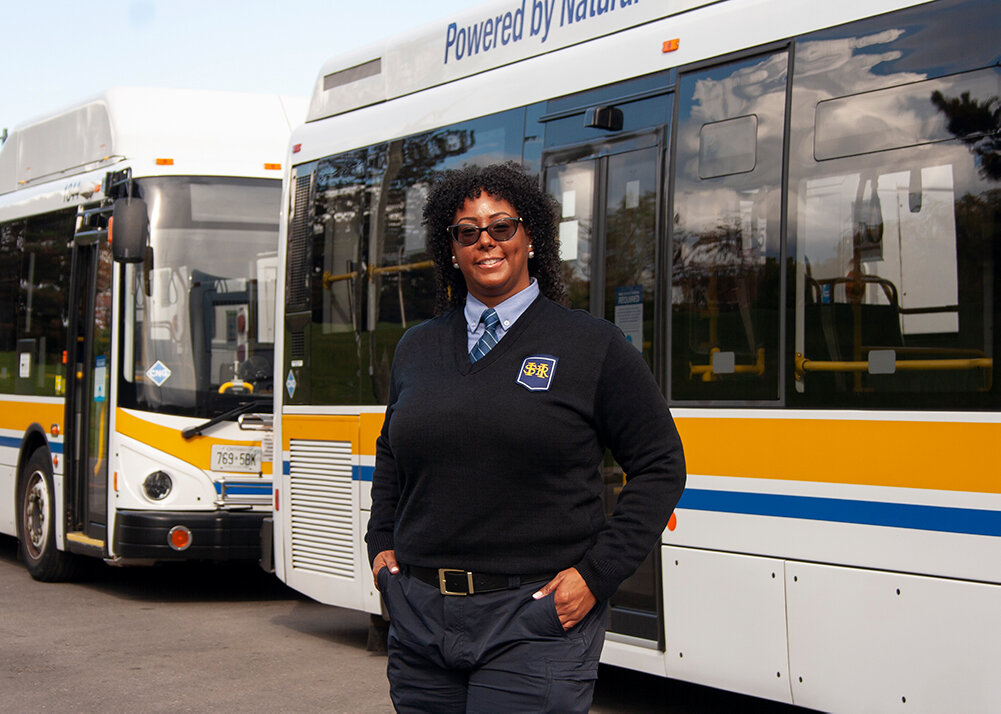Felecia Goulbourne, Bus Driver
COVID Chronicles
Felecia Goulbourne is a bus driver with Hamilton Street Railway (HSR) and a member of the Amalgamated Transit Union (ATU) Local 107. She was born at McMaster University Hospital and spent her childhood living on Queen Street South. Felecia loves to drive and has been a bus driver with HSR for four years. In 2020, her positive energy and determination have helped her cope with the unique challenges presented by COVID-19 but she is filled with uncertainty about the future.



When Felecia was seven years old she drove a vehicle for the first time on her father’s farm in Caledonia. After this experience, a love of driving stuck with her. A family friend who worked for HSR for 44 years recommended she apply for the job four years ago. In contrast to her past work driving large transport trucks, she finds driving an HSR bus similar to driving a minivan. Felecia’s favourite routes to drive are Parkdale in the wintertime, Upper Paradise in the spring and summer, and Stonechurch on Sundays. “I love the social interactions with the regulars, seeing people pick up their kids during rush hours, and the positive community connection.” Recently two passengers boarded Felecia’s bus and said ‘Oh great! The nice bus driver!’ upon seeing her.
Being a bus driver presents everyday challenges, especially when other drivers do not follow the rules of the road. COVID-19 has been difficult for Felecia as her favourite aspect of driving - interacting with her passengers - has been minimized. “The demeanor of the bus has changed a lot, people don’t chat - it’s so quiet, there’s silence” she notes. “The whole social vibration has changed.” For Felecia, COVID-19 has also been “very eye opening to the status of my community. The number of people who are facing difficult times, versus the people who aren’t” she says. Like many people, she believes that public transit should be free in Hamilton to help support working people. “Asking people for fare endangers us. There are countries that do have transit for free. Our government needs to help” she adds.
Hamilton has a long history in the pursuit for accessible, sustainable public transit. At the turn of the 20th century HSR employees were working 14 hour days for a private company and were poorly paid by their employer. In 1899, employees formed as the Hamilton branch of the Amalgamated Street Railway Employees of North America, later to become the Amalgamated Transit Union (ATU). In 1906, they fought for cheaper public power and accessible transit in key strike actions. For over 100 years, the employees of ATU Local 107 have provided transit services to the greater Hamilton community and have fought to keep public transit accessible for all. Presently, transit workers continue to provide vital services in our community as essential workers.
During the pandemic, concerns around the security of personal space have also become heightened on buses. While the installation of shields provides some security for bus drivers, they also create a glare making it difficult to see passengers waiting at bus stops. The reality of the pandemic is unnerving. “As a person of colour I’ve always had a heightened sense of social situations” she says. Her workplace is not exempt from racism or misogyny, which she experiences most often from disgruntled passengers. ”These things have always been prominent in my life whether it’s COVID or not” and are similar to the experiences of other racialized and women bus drivers.
Despite the many challenges presented by work and the pandemic, Felecia has an infectious positivity and warmth which her passengers undoubtedly feel. She maintains her resilience through her self-care routine. “There’s always people who compliment me on my nails when I hand out transfers,” she says. Whether it is getting her hair done, ensuring she has an adequate amount of rest, or finding small moments of joy in the everyday such as honking her bus’ horn for children on the sidewalk, Felecia perseveres.
